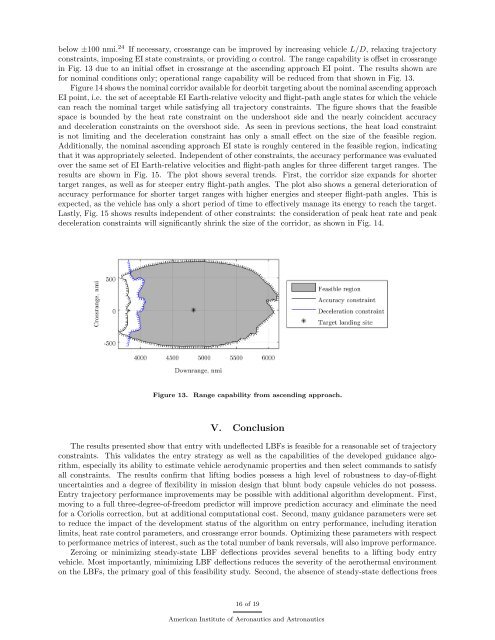Variable Angle-of-Attack Profile Entry Guidance for a Crewed Lifting ...
Variable Angle-of-Attack Profile Entry Guidance for a Crewed Lifting ...
Variable Angle-of-Attack Profile Entry Guidance for a Crewed Lifting ...
You also want an ePaper? Increase the reach of your titles
YUMPU automatically turns print PDFs into web optimized ePapers that Google loves.
elow ±100 nmi. 24 If necessary, crossrange can be improved by increasing vehicle L/D, relaxing trajectory<br />
constraints, imposing EI state constraints, or providing α control. The range capability is <strong>of</strong>fset in crossrange<br />
in Fig. 13 due to an initial <strong>of</strong>fset in crossrange at the ascending approach EI point. The results shown are<br />
<strong>for</strong> nominal conditions only; operational range capability will be reduced from that shown in Fig. 13.<br />
Figure 14 shows the nominal corridor available <strong>for</strong> deorbit targeting about the nominal ascending approach<br />
EI point, i.e. the set <strong>of</strong> acceptable EI Earth-relative velocity and flight-path angle states <strong>for</strong> which the vehicle<br />
can reach the nominal target while satisfying all trajectory constraints. The figure shows that the feasible<br />
space is bounded by the heat rate constraint on the undershoot side and the nearly coincident accuracy<br />
and deceleration constraints on the overshoot side. As seen in previous sections, the heat load constraint<br />
is not limiting and the deceleration constraint has only a small effect on the size <strong>of</strong> the feasible region.<br />
Additionally, the nominal ascending approach EI state is roughly centered in the feasible region, indicating<br />
that it was appropriately selected. Independent <strong>of</strong> other constraints, the accuracy per<strong>for</strong>mance was evaluated<br />
over the same set <strong>of</strong> EI Earth-relative velocities and flight-path angles <strong>for</strong> three different target ranges. The<br />
results are shown in Fig. 15. The plot shows several trends. First, the corridor size expands <strong>for</strong> shorter<br />
target ranges, as well as <strong>for</strong> steeper entry flight-path angles. The plot also shows a general deterioration <strong>of</strong><br />
accuracy per<strong>for</strong>mance <strong>for</strong> shorter target ranges with higher energies and steeper flight-path angles. This is<br />
expected, as the vehicle has only a short period <strong>of</strong> time to effectively manage its energy to reach the target.<br />
Lastly, Fig. 15 shows results independent <strong>of</strong> other constraints: the consideration <strong>of</strong> peak heat rate and peak<br />
deceleration constraints will significantly shrink the size <strong>of</strong> the corridor, as shown in Fig. 14.<br />
Figure 13.<br />
Range capability from ascending approach.<br />
V. Conclusion<br />
The results presented show that entry with undeflected LBFs is feasible <strong>for</strong> a reasonable set <strong>of</strong> trajectory<br />
constraints. This validates the entry strategy as well as the capabilities <strong>of</strong> the developed guidance algorithm,<br />
especially its ability to estimate vehicle aerodynamic properties and then select commands to satisfy<br />
all constraints. The results confirm that lifting bodies possess a high level <strong>of</strong> robustness to day-<strong>of</strong>-flight<br />
uncertainties and a degree <strong>of</strong> flexibility in mission design that blunt body capsule vehicles do not possess.<br />
<strong>Entry</strong> trajectory per<strong>for</strong>mance improvements may be possible with additional algorithm development. First,<br />
moving to a full three-degree-<strong>of</strong>-freedom predictor will improve prediction accuracy and eliminate the need<br />
<strong>for</strong> a Coriolis correction, but at additional computational cost. Second, many guidance parameters were set<br />
to reduce the impact <strong>of</strong> the development status <strong>of</strong> the algorithm on entry per<strong>for</strong>mance, including iteration<br />
limits, heat rate control parameters, and crossrange error bounds. Optimizing these parameters with respect<br />
to per<strong>for</strong>mance metrics <strong>of</strong> interest, such as the total number <strong>of</strong> bank reversals, will also improve per<strong>for</strong>mance.<br />
Zeroing or minimizing steady-state LBF deflections provides several benefits to a lifting body entry<br />
vehicle. Most importantly, minimizing LBF deflections reduces the severity <strong>of</strong> the aerothermal environment<br />
on the LBFs, the primary goal <strong>of</strong> this feasibility study. Second, the absence <strong>of</strong> steady-state deflections frees<br />
16 <strong>of</strong> 19<br />
American Institute <strong>of</strong> Aeronautics and Astronautics
















